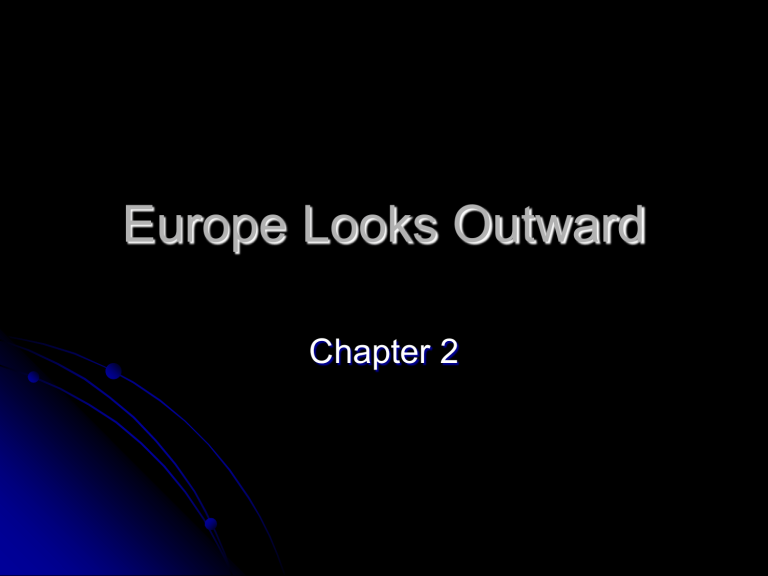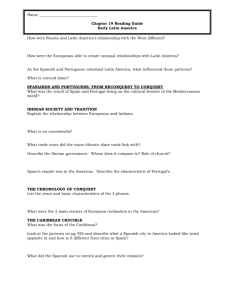Europe Looks Outward

Europe Looks Outward
Chapter 2
The Age of Exploration
In about 1001, the
Vikings from
Scandinavia arrived in North America
Leif Erikson and 35 other sailors left from
Greenland to North
America
The Age of Exploration
Christopher Columbus believed he could reach
Asia by sailing west across the Atlantic
Ocean
He learned all he knew from working on
Portuguese ships, but when he tried to get his own ship, the King turned him down.
He moved to Spain and presented his plan to
King Ferdinand and
Queen Isabella, who gave Columbus money for his trip
The Age of Exploration
In August of 1492,
Columbus and 90 men set sail on three ships, the Nina, the Pinta and the Santa Maria
After three months,
Columbus found land and claimed it for
Spain. Thinking it was
India, he called the people on the land
Indians.
Columbus then sailed south and found the island of Cuba
The Age of Exploration
Columbus traveled back to Spain in January of
1493, and claimed that there was lots of gold in the “West Indies”
Columbus made three more voyages to what he thought was India, he found present day Puerto
Rico and northern South
America
The Age of Exploration
Many explorers followed the route charted by Columbus
In 1510, Spanish explorer
Vasco Nunez de Balboa, explored the Caribbean coast of Panama, he also went through the forest and saw the Pacific
Ocean
In September 1519,
Portuguese explorer,
Ferdinand Magellan planned to find a passage from the Atlantic to the Pacific
The Age of Exploration
For more then one year, his fleet traveled down the South
American coast looking for a strait.
They traveled so far south, they saw penguins
Magellan finally reached the Philippine
Islands, where he was killed in battle.
The survivors fled in two ships, they reached Spain in
September 1522, after circumnavigating the earth.
The Age of Exploration
All of this exploration began the Columbian
Exchange
This was a transfer of people, products and ideas between hemispheres
Positive effects were the transfer of animals and food plants
Negative effects was the transfer of germs, which killed the Native
Americans
Spain’s Empire in the Americas
By the early 1500’s the Spanish were in the Americas
Spanish explorers are called conquistadors and wanted to explore the world.
Spain’s Empire in the Americas
In 1519, conquistador
Hernando Cortes sailed from Cuba to Mexico
By November, he went to the Aztec capital of
Tenochtitlan
The Aztec leader
Montezuma tried to get
Cortes to leave by offering him gold.
Cortes held
Montezuma captive, but the Aztecs rebelled and forced the Spaniards to flee
A year later, Cortes returned and destroyed
Tenochtitlan. He built
Mexico City
Spain’s Empire in the Americas
Another conquistador,
Francisco Pizarro, landed on the coast of
Peru in 1531.
By September 1532, he led his soldiers into the center of the Incan
Empire and took it over, by November
1533, The Spanish took over the capital city of Cuzco
Spain’s Empire in the Americas
There were many reasons that the
Spaniards beat the native American
Armies
The Spanish used armor, muskets and canons
The Spanish rode horses
The Natives were divided before the
Spanish had arrived
Spain’s Empire in the Americas
In 1513, Juan Ponce de
Leon, sailed from Puerto
Rico and found Florida
After 8 years in Florida, only four of 400 explorers remained alive because of starvation, disease and becoming enslaved
Spain had to create a formal system of government its new colonies
The government gave settlers large sections of lands to start mines, ranches and plantations.
Spain’s Empire in the Americas
Spain also gave the colonists encomiedas, and forced the natives to work in the gold and silver mines.
Bartoleme de Las
Casas, a priest, traveled to New Spain to try and change the encomiedas system because so many
Natives were dying.
The Spanish also believed that they had to convert the Natives to Christianity, they set up missions
Spain’s Empire in the Americas
Because so many
Native workers were dying, the Spanish looked for a new source of labor.
In 1517, they brought
Africans to the
Caribbean islands to work for them
Spain’s Empire in the Americas
There was a social class system in the colonies that was based on birthplace and ethnic group.
On the top was the peninsulares-the Spanish colonists born in Spain
A Creole was someone who was born to peninsulare parents in the colony
A Mestizo was a person who had both Spanish and Native parents
The lowest were mulatto, which were people of
Spanish and African heritage
Europeans Compete in North
America
By 1530, Europe had been split between the Roman
Catholic Church and the Protestant
Church.
England had become
Protestant because the King wanted a divorce and the
Catholic Church would not allow it.
Europeans Compete in North
America
Religious tensions caused uncertainty, which made
European leaders to think that they could not trust each other.
This led to mercantilism, which the mother country relied on the colonies, not another country.
Europeans Compete in North
America
After a series of deaths in the royalty of England,
Protestant Queen
Elizabeth I restarted the rivalry with Roman
Catholic Spain.
The British even attacked
Spanish ships at sea.
By 1588, Phillip, the leader of Spain, took 130 warships and began the
Spanish Armada, or an attack on England.
The English ships were faster and sand many of the Spanish Ships-this was an embarrassing loss for the Spanish
Europeans Compete in North
America
John Cabot, an
Italian native, began to explore for
England and left for the North Atlantic in
May 1497
He explored
Newfoundland and may have explored
Chesapeake Bay, we do not know because his ship disappeared
Europeans Compete in North
America
England, France and Holland realized that the new lands were not Asia and began to look for the Northwest
Passage.
In 1524, Giovanni da Verrazano, searched for the passage for
France.
He explored from North Carolina to Newfoundland.
Jacque Cartier also made three trips to the New World from
France, he discovered the St.
Lawrence River and went up to
Montreal
Europeans Compete in North
America
English explorer, Henry
Hudson, made four voyages to find the North
West Passage.
By 1609, he reached New
York and what is now the
Hudson River
On his fourth trip, his crew was very unhappy with the icy waters they found themselves in so they mutinied against him, and threw him and his son off the boat.
France and the Netherlands in
North America
The French began to settle colonies in the early 1600’s
In 1603, Samuel de
Champlain made his first voyage to the St.
Lawrence River, when he returned, he established Quebec
France and the Netherlands in
North America
The French were different then the
Spanish, in New Spain, the Spanish wanted gold, silver and precious metals. The
French wanted furs and fish
The French traded with the Native Americans, they did not enslave them.
Champlain established the first trading post, in
Nova Scotia in 1604.
France and the Netherlands in
North America
It was not until the late
1600’s that the French began to farm.
In 1670, French missionary Jacque
Marquette founded two missions along the
Great Lakes
In 1673, Marquette and
Louis Joliet, a trader, found what is now Green
Bay, Wisconsin.
They found the
Mississippi River, and traveled down, to the
Arkansas River
France and the Netherlands in
North America
The Dutch also claimed land based on Henry Hudson.
In 1610, Dutch traders began to trade with the Native
Americans.
They made so much money, they set up the Dutch West India
Company
This land that the
Dutch settled was called New
Netherland.
France and the Netherlands in
North America
The British wanted this land because it prevented the settlers from moving westward.
The British seized
New Netherland and renamed the territory New York, after the Kings brother, the Duke of
York.
France and the Netherlands in
North America
The Dutch and the
French began to make alliances with the Native
Americans.
The French became trading partners with the Huron’s
The Huron’s and
Iroquois were enemies so the
Dutch became trading partners with the Iroquois.




